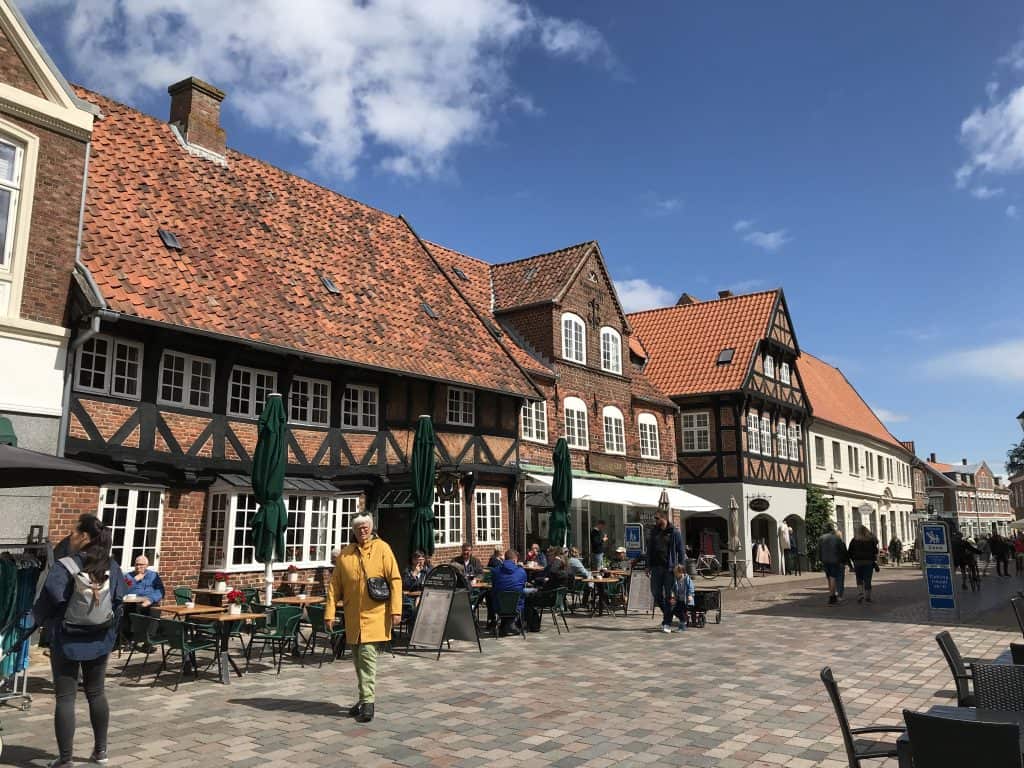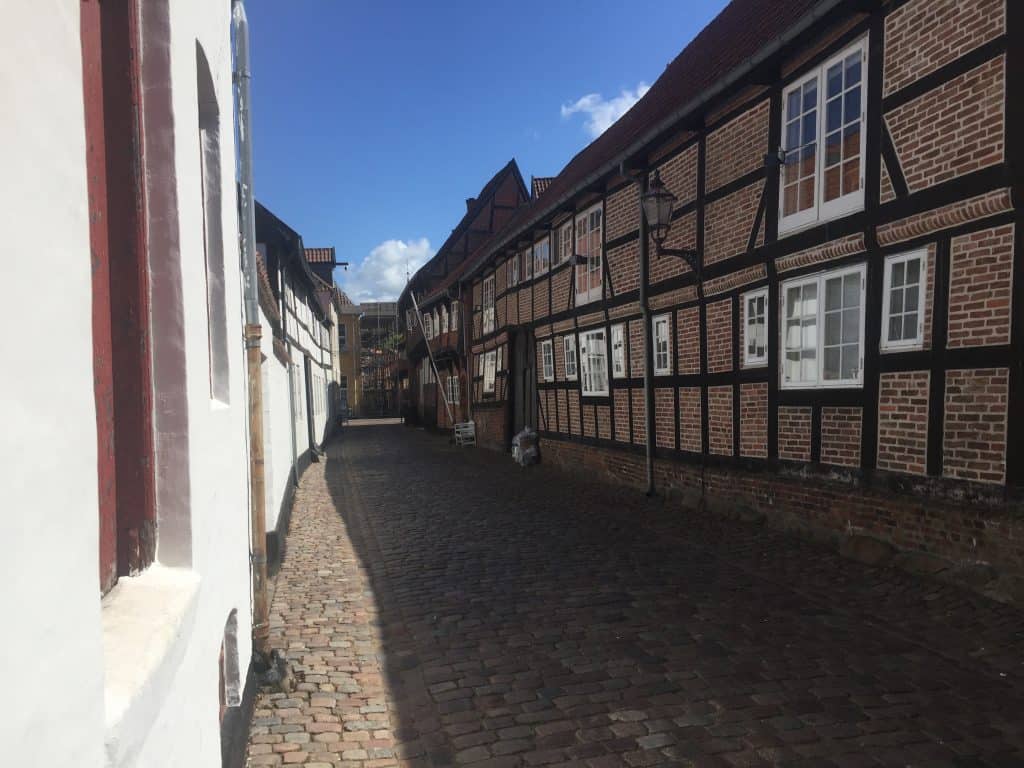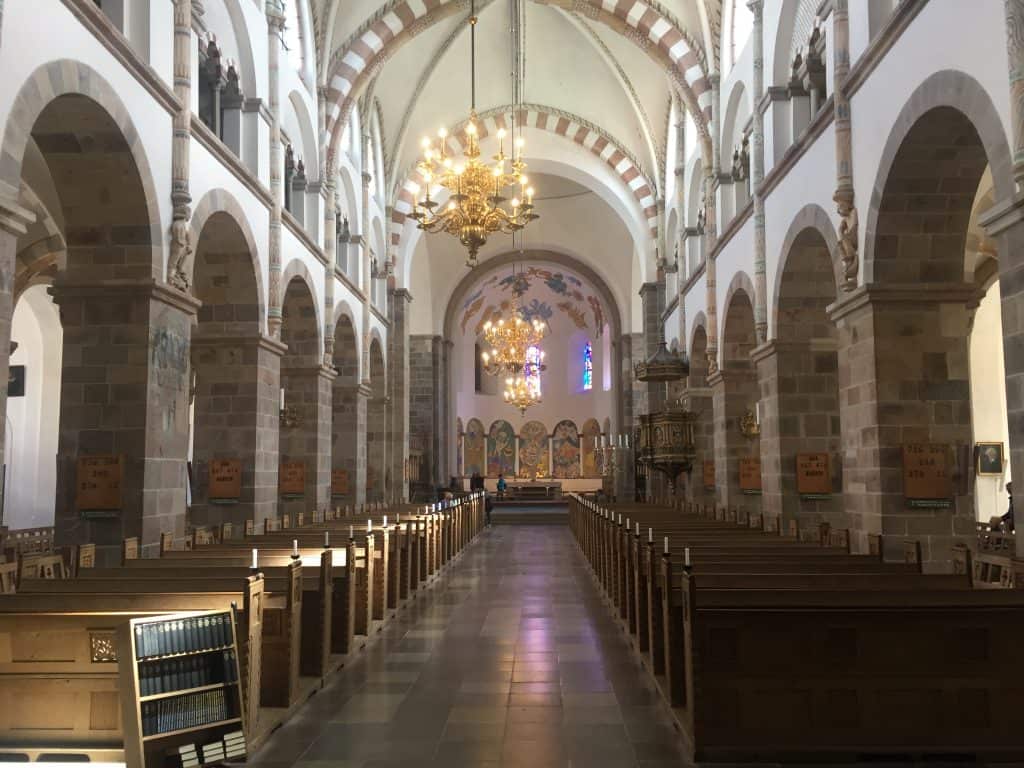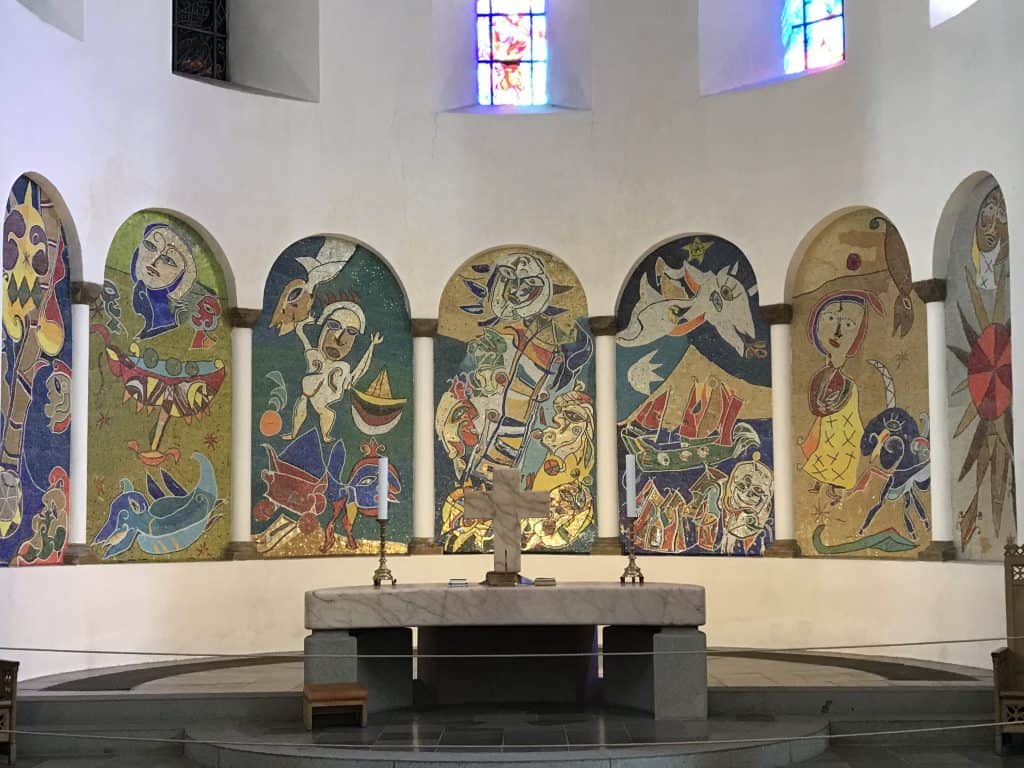We realised we would be in Esbjerg for some while as days of gales were forecast. The local Esbjerg Søsport Club (watersports club) have been very helpful and arranged electricity for us.
We have used the time to catch up on correspondence as best we can without WiFi, dealing with laundry etc. and done some mid-season maintenance.
Esbjerg
We are located in a brand new marina, which opened this year. At this stage there are just the pontoons and it is located in something of a dessert of sandy gravel – no doubt what was dredged out to make it.
We are close to Esbjerg’s iconic giant sculpture “Man meets the sea”
Ribe
One day we had an enjoyable excursion by train to Ribe – the oldest city in Denmark and no longer a port. Because Esbjerg has taken the modern developments, Ribe has survived more or less in its original form and is a maze of narrow cobbled streets clustering around the magnificent Domkirke (cathedral). From the top of the tower is a magnificent view over the red-tiled roofs and out to the Waddensee. We could see all three Danish Waddensee islands Fanø, Mandø and Rømø.
Opposite the port of Esbjerg is the island of Fanø – the northernmost Frisian island. With Antipole tucked up snuggly during the gales, we chose to visit by ferry.
Fanø
Fanø is a long thin island and, as with other Frisian islands has a long sandy beach to seaward and marshy land on the inside. The beach is some 10nm and completely flat, so it is a Mecca for all manner of wind and kite surfers. We hear that even Formula 1 cars have raced on it.
We cycled the 14km to the southern tip of Fanø and the village of Sønderho. From ca. 1760 right through to 1896 Sønderho had a ship building yard, the most important on the west coast of Jutland It built around 1100 wooden ships. However, the harbour gradually silted up with sand and building moved elsewhere. Today, the harbour looks out over grasslands and just a trickle of water reaches it at high tide.
New developments have taken place at Esbjerg, so Sønderho has been left little changed – indeed it claims an award as the most beautiful village in Denmark. The mostly thatched cottages retain the arched gable over the front door which gives access to the hayloft. We visited one of the cottages which was lived in by a sea captain’s widow Hanne, who kept it virtually unchanged . She lived in it right up until 1965, when she bequeathed it as a museum.
Most of the churches we have visited in Scandinavia have a votive ship hanging from the ceiling. Votive ships were model ships given by sea farers or ship builders in thanks for the their good fortune, whether in wealth or escape from ship wrecks. We have seen a church with two. In Sønderho the church has fifteen – witnessing the importance of ships to the village.

Sønderho cottage 
Sønderho cottage 
Sønderho fire station 
Sønderho fire appliance 
Sønderho church 
Votive ships
Islanders are an independent lot and, despite the small population, Fanø remains an independent municipality to this day. This dates back to 1741, when the crown decided to sell Fanø to raise funds for other projects. Would-be buyers gathered in Ribe for the auction. There are several stories about what happened – some say that on the eve of the auction, young women from Fanø lured away the bidders to a night of drink and merriment and while the men were distracted, set their watches back. Another bidder was physically detained. Whatever, come the appointed time, only islanders were present and the island was purchased for a nominal sum.
Esbjerg to Amrum
The strong winds and gales pinned us down in Esbjerg for twelve days – a record for us. We needed the wind to ease not just for a day but long enough for the seas to abate and for safe passage onwards. To call at the islands, we have to enter the ‘seegats’ – the passages inbetween the islands, mostly shallow and with strong ebbs and flows. We needed wind strong enough to sail but not more than F4 if on-shore, as it mostly is.
Eventually, we got one good day with a nice NW F4 and sun! We decided we needed to make the most of it and bypassed Rømø and Sylt, where we might have called if we had not lost so many days.
Sylt is the northernmost of the German islands and is long north to south. It has a history as a resort and claims to be the playground of the rich and famous. Whether they still go there we do not know, but there are said to be lots of visitors hoping to catch a glimpse of them. We sailed by 5nm off-shore and a safe distance from such concerns.
Amrum
The next island south is Amrum. On its western side is a particularly wide sand beach. About one third of the population speak Öömrang, a North Frisian dialect which can be understood by speakers of Fering from the neighbouring island of Föhr but no others – not even from neighbouring Sylt.
We berthed in the yacht harbour at Wittdün at the south end. We enjoyed cycling up to the north and through the capital village Nebel, which has many very pretty thatched cottages. Tourism and summer visitors are the mainstay of the economy and Nebel was packed, so we did not dally. In the northern village of Norddorf we stopped for tea and cake. Tony ordered Frisiantorte, which turned out to be a gateau of flaked pastry filled with whipped cream laced with plum sauce. Its size and richness was challenging, and he was glad of the cycle ride back through a forest track. Unfortunately, the weather was misty and this limited the views.
The Eider River
We had hoped to visit more of the North Frisian islands, but, given time and tide constraints and wind forecasts, we decided to get into the River Eider while the going was good. A 43nm passage brought us into the Eider delta and to the Eidersperrwerk – a 4.8km barrage that is mostly kept open except in times of storm surges or when the waters are held back prior to flushing out the approach channel. We waited overnight before locking through into the river.
The lower part of the Eider River is a wide expanse of tidal mud flats. These are very important feeding and resting grounds for sea birds. 7nm up the river we came to the old town of Tönning.
Tönning
Historically, this whole area has suffered from storm surges and floods. At various times in the 1600s, Dutch settlers were tempted in with the promise of land that they poldered. So the landscape is quite Dutch and Tönning Dutch-like.
In 1784 the Eider canal opened a route from the North Sea via the Eider through to the Baltic, thus avoiding the tortuous route around the Jutland peninsular. Tönning became an important trading point on this route. We are berthed by the enormous packhaus – witness those times – which today serves as a community hall. In 1895 the Kiel canal was opened to facilitate the passage of larger naval ships and the Eider route went into decline.
We turned off the river into Tönning harbour, which is lined with Dutch-like houses. This harbour is tidal and we dry out on the mud at low water. With our lifting keel this is not a problem for us, but we have a schedule of closing the sea cocks to prevent ingress of mud and opening them again when afloat to drain off waste water etc. Washing up has to wait for the tide. One day the tide did not go out as expected! This was because the Eidersperrwerk had held the waters back, either because of the engineering works or to build up a head of water to flush out the approach channels.

Dutch-style houses in Tönning 
Barrel-vault ceiling with paintings in Tönning church 
Tönning harbour 
English 4.5 ton crane built 1834 
Afloat in Tönning 
On the mud in Tönning
Friedrichstadt
We cycled 18km to the town of Friedrichstadt. In the 1600s, Duke Friedrich invited religious refugees from the Netherlands to settle here and to solve the drainage problems as only the Dutch could do.
They solved the drainage problems the Dutch way and today Friedrichstadt seems like a classic Dutch town, serviced by canals and surrounded by a singel. Most of the older houses are typically Dutch in style and beautifully preserved.
The settlers were given freedom to practice their religions. Some were Roman Catholic but most were Remonstrants – so called because they remonstrated against the Calvin doctrine of predestination. The town has Lutheran, Roman Catholic and Remonstant churches still active today.
We also visited the former synagogue where an artist working in metal and ceramics had a most powerful exhibition meditating on man’s inhumanity. After much discussion about the exhibition, we were invited to view an exhibition by a painter and art psychotherapist – again very powerful work.

Market square Friedrichstadt 
Dutch-style houses 
Dutch-style houses 
Dutch interior with bed cupboard 
Canal trips like in Amsterdam 
Remonstrator church
We will be leaving Antipole in Tönning for a few days while we take trains to Hamburg airport to fly back to the UK to see Tony’s son Rick and his family, who are visiting from New Zealand.
Tony & Ynskje








Thanks for the fascinating and historical information also the great pictures.